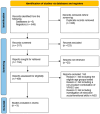Non-Invasive BCI-VR Applied Protocols as Intervention Paradigms on School-Aged Subjects with ASD: A Systematic Review
- PMID: 40096108
- PMCID: PMC11902634
- DOI: 10.3390/s25051342
Non-Invasive BCI-VR Applied Protocols as Intervention Paradigms on School-Aged Subjects with ASD: A Systematic Review
Abstract
This paper aims to highlight non-invasive BCI-VR applied protocols as intervention paradigms on school-aged subjects with ASD. Computer-based interventions are considered appropriate for users with ASD as concentration on a screen reduces other stimuli from the environment that are likely to be distracting or disruptive. Since there are no social conditions for engagement in such processes and the responses of computing systems do not hold surprises for users, as the outputs are fully controlled, they are ideal for ASD subjects. Children and adolescents with ASD, when supported by BCI interventions through virtual reality applications, especially appear to show significant improvements in core symptoms, such as cognitive and social deficits, regardless of their age or IQ. We examined nine protocols applied from 2016 to 2023, focusing on the BCI paradigms, the procedure, and the outcomes. Our study is non-exhaustive but representative of the state of the art in the field. As concluded by the research, BCI-VR applied protocols have no side effects and are rather easy to handle and maintain, and despite the fact that there are research limitations, they hold promise as a tool for improving social and cognitive skills in school-aged individuals with ASD.
Keywords: EEG signals; autism spectrum disorder (ASD); brain–computer interface (BCI); emotional regulation; joint attention; memory; neurofeedback (NFT); social skills; virtual reality (VR).
Conflict of interest statement
The authors declare no conflicts of interest.
Figures
References
-
- American Psychiatric Association . Diagnostic and Statistical Manual of Mental Disorders. 5th ed. American Psychiatric Association; Washington, DC, USA: 2013. - DOI
-
- World Health Organization, 2019 ICD-11: 6A02—Autism Spectrum Disorder. [(accessed on 22 July 2024)]. Available online: https://icd.who.int/en.
-
- Van Kokswijk J., Van Hulle M. Self-adaptive BCI as service-oriented information system for patients with communication disabilities; Proceedings of the 4th International Conference on New Trends in Information Science and Service Science; Gyeongju, South Korea. 11–13 May 2010; pp. 264–269.
Publication types
MeSH terms
LinkOut - more resources
Full Text Sources
Medical
Research Materials







